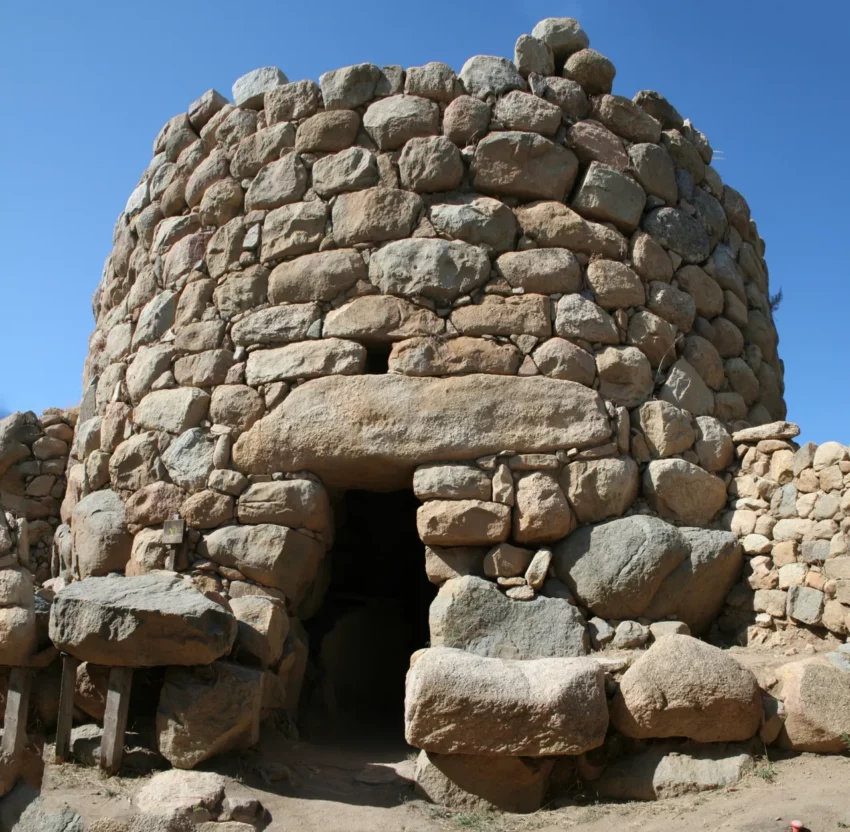Get your dose of History via Email
The Nuraghe La Prisgiona and Its Archaeological Context
The Nuraghe La Prisgiona is a significant Nuragic complex located on the island of Sardinia. The settlement is situated in the region of Gallura, within the commune of Arzachena. Dated to around 1800-1600 BC, the complex exhibits the advanced architectural prowess of the Nuragic civilization, a culture indigenous to Sardinia that flourished in the Bronze Age.
Architectural Layout and Features
La Prisgiona is composed of a central tower known as a ‘mastio’ or keep, which was constructed using the typical tholos technique: a corbelled stone roof over a circular room. This principal tower is flanked by two secondary towers, forming a bastion likely used for defensive purposes. The meticulous use of massive stones in the construction process is a clear indication of the engineering skills of the Nuragic people. The complex was enclosed by a stone rampart and incorporated within an ancient village comprising more than 90 structures, including circular huts, areas for meetings and religious practices, and a variety of functional buildings.
Archaeological Investigations
Examinations of the site have revealed extensive insight into the Nuragic culture. The architectural complex is complemented by the nearby presence of a ‘giant’s grave’, a collective burial monument typical of Sardinian Bronze Age society. Excavations at La Prisgiona have unearthed a substantial amount of artefacts such as ceramics, metal objects, and lithics, which are integral to understanding the daily life, economy, and social structures of the Nuragic inhabitants.
Current Understanding and Research
La Prisgiona stands as a hallmark of prehistoric Sardinian architecture. Ongoing archaeological research continues to unravel the history and function of such Nuragic complexes. The structures are generally thought to have served various purposes such as religious, military, and communal gathering spaces.
Conservation Efforts and Public Engagement
Presently, the site is part of the Arzachena archaeological park and is open to public viewing. Conservation efforts have been implemented to ensure the protection and preservation of this historic edifice. It is recognized as one of the most significant and well-preserved Nuragic complexes available for study, offering visitors and scholars alike a window into the Bronze Age of Sardinian history.
Importance to Nuragic and Sardinian Heritage
Nuraghe La Prisgiona is a testament to the architectural and cultural accomplishments of the Nuragic civilization. As a part of a vast number of Nuragic remains scattered across Sardinia, La Prisgiona contributes greatly to our understanding of this prehistoric society’s significant impact on the Mediterranean during the Bronze Age. It serves as an iconic representation of a past era and is pivotal to both local Sardinian identity and the broader historical narrative of human settlement and development in the Mediterranean basin.
Conclusion: Reflecting on the Historical Significance
In conclusion, the Nuraghe La Prisgiona offers an essential glimpse into an ancient and relatively obscure civilization. Its well-preserved condition and the research carried out on the complex shed light on certain aspects of Nuragic life — from their construction techniques to social organization, and their interactions with the environment and beyond. As excavations and studies continue, we can anticipate that the Nuraghe La Prisgiona will reveal even more about the Bronze Age society that created it, and help to deepen our understanding of the broader prehistoric landscape of the Mediterranean.

